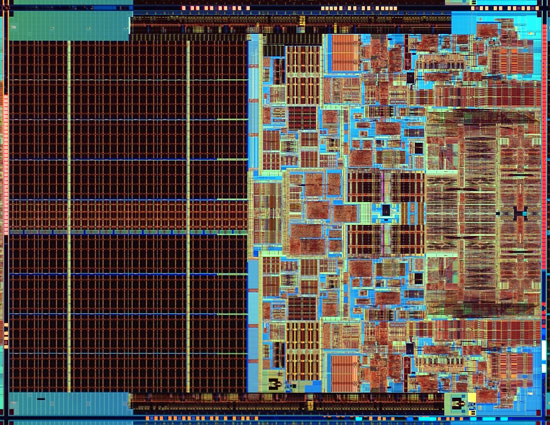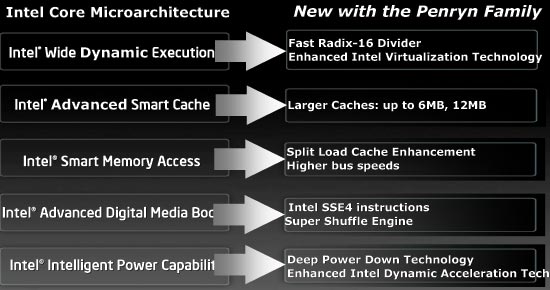The Penryn Preview - Part I: Wolfdale Performance
by Anand Lal Shimpi on August 21, 2007 12:35 PM EST- Posted in
- CPUs
By the end of this year, AMD will introduce Phenom and Intel will introduce Penryn - its first 45nm desktop CPU.
For a while there we wondered how Intel would introduce Penryn into its lineup, but as of Intel's last roadmap update we now know. On top of that, we managed to get our hands on a dual-core Penryn so now we know exactly how fast the new core is going to be. Combine the two datapoints and there's a wealth of knowledge to share. So gather 'round the fire, it's time to benchmark CPUs.
Recapping Penryn
Penryn is more than just a die-shrunk Conroe, but it isn't anywhere near as revolutionary as what Conroe was to its predecessor. The Conroe-Penryn evolution is one cycle of Intel's tick-tock model, Penryn's successor (Nehalem) will be the next revolutionary core you see out of Intel (at least that's what we're expecting).

Penryn is built on Intel's 45nm process, thus dropping power consumption increasing switching speed and allowing Intel to cram more transistors on a die (107mm^2 for dual-core Penryn vs. 143mm^2 for Conroe).

A dual-core Penryn die

A dual-core Conroe die
Intel lists the following 9 enhancements as what's new in the Penryn family:

The faster divider and super shuffle engine will increase performance in very specific applications and won't be broad increasers of performance. The larger caches obviously will increase performance, but prior to today we weren't sure by how much.
SSE4 support can bring about tremendous performance improvements, but it requires software optimization. In our initial Penryn Preview we reported an over 100% increase in performance in SSE4 optimized DivX encoding for a quad-core Penryn at 3.33GHz vs. a quad-core Kentsfield at 2.93GHz.
We detailed all of the Penryn enhancements and the markets they impact in our original Penryn article. Keep in mind that things like Penryn's Deep Power Down Technology and higher bus speeds may not apply to all Penryn cores (the former is only in Mobile Penryn while the latter will appear on servers first).
Never Take Sides Against the Family
Penryn is the overall family name but there are two cores in particular that we'll be talking about today: Wolfdale and Yorkfield.
Wolfdale is a dual-core desktop Penryn core with a 6MB L2 cache shared between the two cores. Yorkfield is two Wolfdales on the same package, giving the quad-core CPU a total of 12MB of L2 cache.
Wolfdale and Yorkfield are architecturally identical, so performance per core is no different between the processors - Yorkfield simply has more cores.










55 Comments
View All Comments
Owls - Wednesday, August 22, 2007 - link
is it me or did the first image just look like a bunch of penises?Epyon - Thursday, August 23, 2007 - link
Its just youstrikeback03 - Thursday, August 23, 2007 - link
Apparently not. See the dailytech link from johnsonx below.Lord Evermore - Sunday, August 26, 2007 - link
If your wang looks so similar to those charts that you saw penis in the image, you might need to get some medical attention. Or join a circus.GhandiInstinct - Tuesday, August 21, 2007 - link
Now I just need to figure out when and what to buy as my GFX Card.